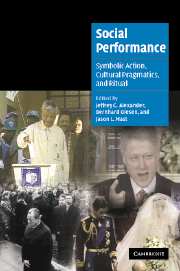Book contents
- Frontmatter
- Contents
- List of figures
- List of tables
- List of contributors
- Introduction: symbolic action in theory and practice: the cultural pragmatics of symbolic action
- 1 Cultural pragmatics: social performance between ritual and strategy
- 2 From the depths of despair: performance, counterperformance, and “September 11”
- 3 The cultural pragmatics of event-ness: the Clinton / Lewinsky affair
- 4 Social dramas, shipwrecks, and cockfights: conflict and complicity in social performance
- 5 Performing a “new” nation: the role of the TRC in South Africa
- 6 Performing opposition or, how social movements move
- 7 Politics as theatre: an alternative view of the rationalities of power
- 8 Symbols in action: Willy Brandt's kneefall at the Warsaw Memorial
- 9 The promise of performance and the problem of order
- 10 Performance art
- 11 Performing the sacred: a Durkheimian perspective on the performative turn in the social sciences
- Index
- Cambridge Cultural Social Studies
- References
6 - Performing opposition or, how social movements move
Published online by Cambridge University Press: 07 December 2009
- Frontmatter
- Contents
- List of figures
- List of tables
- List of contributors
- Introduction: symbolic action in theory and practice: the cultural pragmatics of symbolic action
- 1 Cultural pragmatics: social performance between ritual and strategy
- 2 From the depths of despair: performance, counterperformance, and “September 11”
- 3 The cultural pragmatics of event-ness: the Clinton / Lewinsky affair
- 4 Social dramas, shipwrecks, and cockfights: conflict and complicity in social performance
- 5 Performing a “new” nation: the role of the TRC in South Africa
- 6 Performing opposition or, how social movements move
- 7 Politics as theatre: an alternative view of the rationalities of power
- 8 Symbols in action: Willy Brandt's kneefall at the Warsaw Memorial
- 9 The promise of performance and the problem of order
- 10 Performance art
- 11 Performing the sacred: a Durkheimian perspective on the performative turn in the social sciences
- Index
- Cambridge Cultural Social Studies
- References
Summary
Introduction
The concept of social movement is a well-established term in the sociological lexicon. The aim of this chapter is not so much to once again attempt to define a social movement or to offer criteria for determining when forms of collective action qualify as genuine movements. In fact, some of the examples I use to illustrate my argument are not taken from “social movements” properly defined. Rather, the aim is to explore what “movement” means, and to ask what is or can be said to be “moved” in the performance of opposition or extended protest. Social movement is a form of acting in public, a political performance which involves representation in dramatic form, as movements engage emotions inside and outside their bounds attempting to communicate their message. Such performance is always public, as it requires an audience which is addressed and must be moved. Following Goffman (1971) and others (for example, Schechner 1985; Hetherington 1998; Apter, chapter 7, this volume; Alexander, chapter 1, this volume), the application of a theory of performance calls attention to the place and space of movement, as well as how opposition is performed. Performance theory focuses on corporality, presence, and the pre-discursive, while at the same time including it. This allows us to better address questions concerning what happens when people enter a movement, how this affects their actions and the actions of others, and to ask how social movements move.
- Type
- Chapter
- Information
- Social PerformanceSymbolic Action, Cultural Pragmatics, and Ritual, pp. 193 - 217Publisher: Cambridge University PressPrint publication year: 2006
References
- 82
- Cited by



